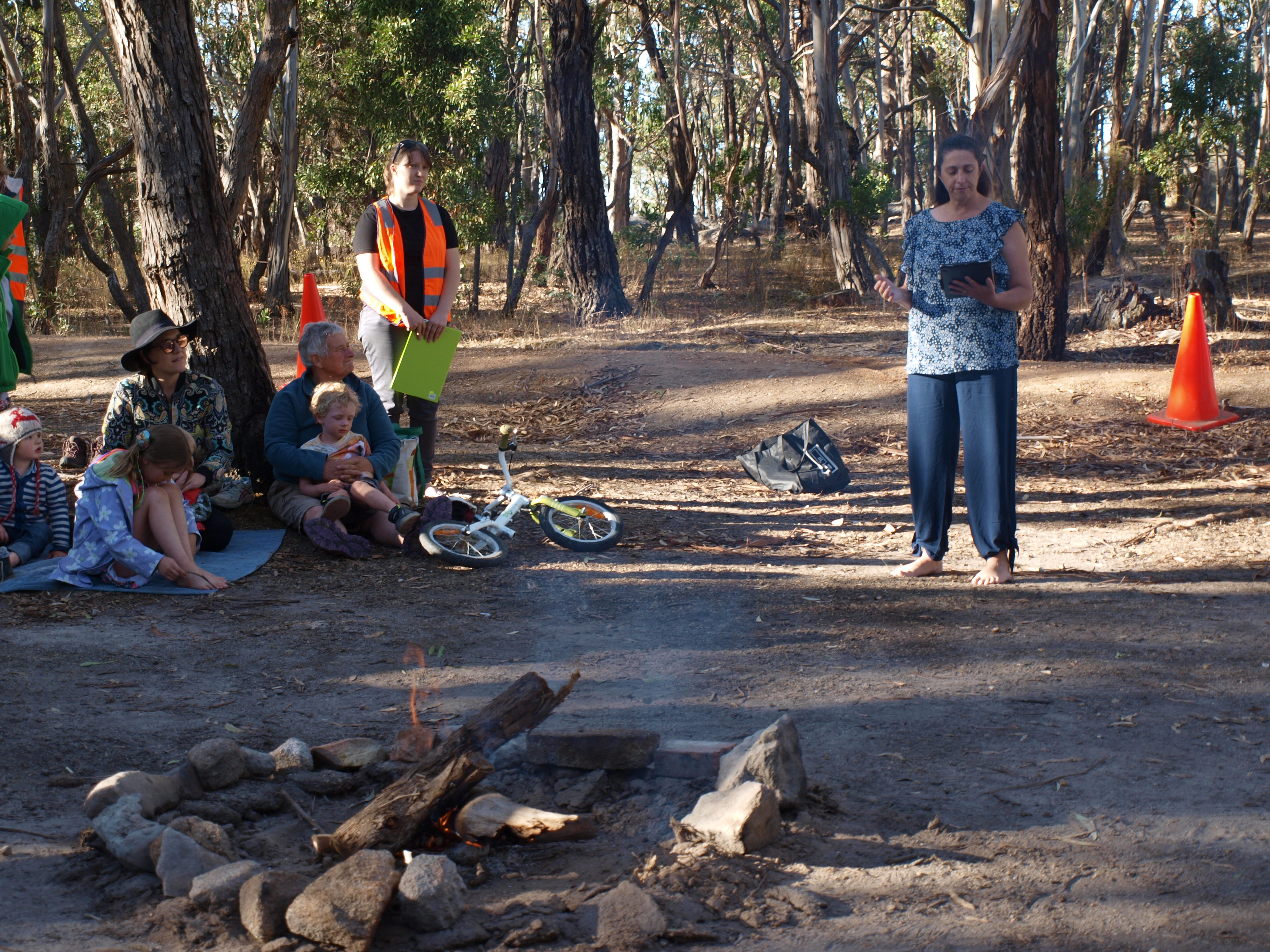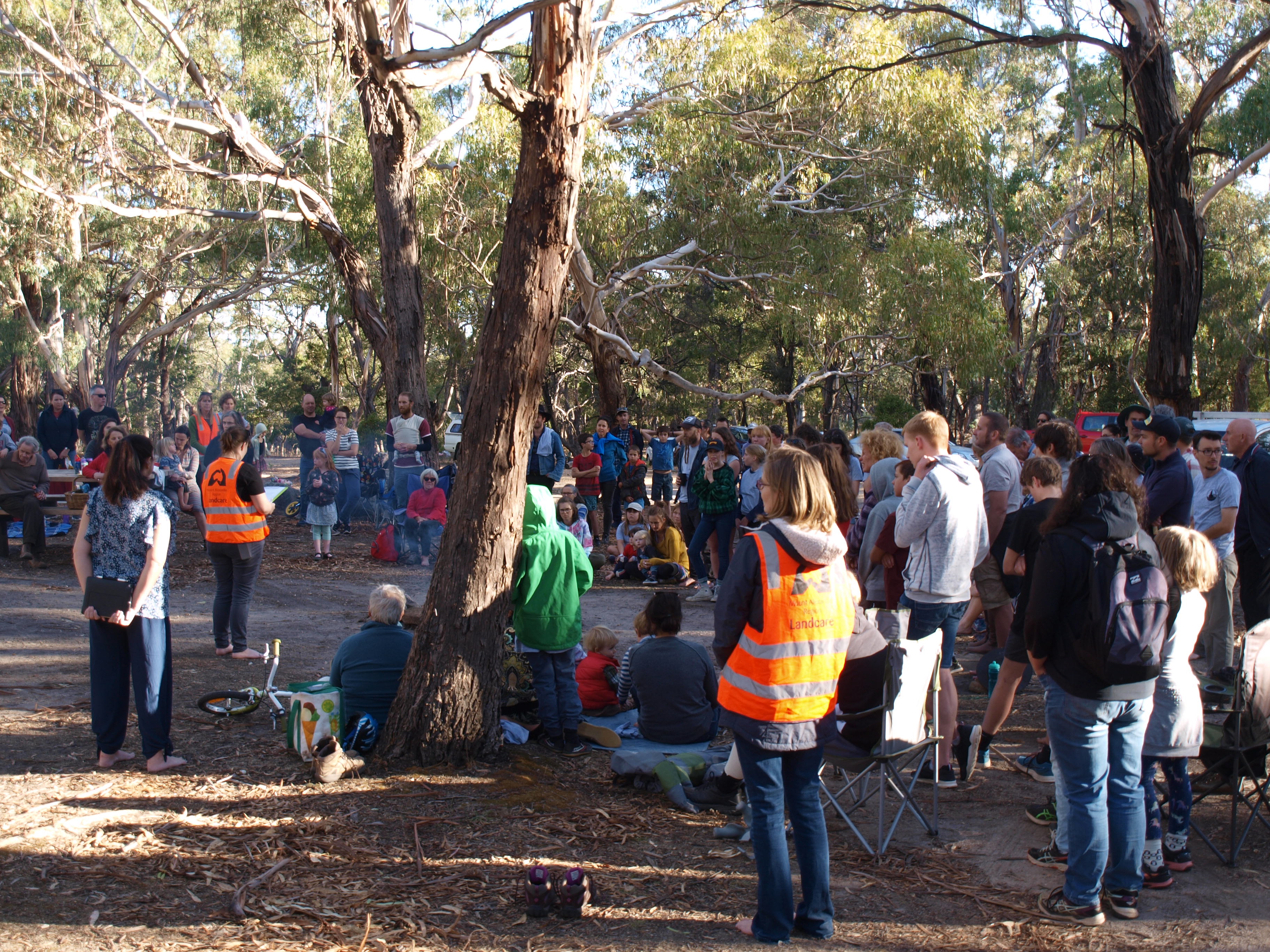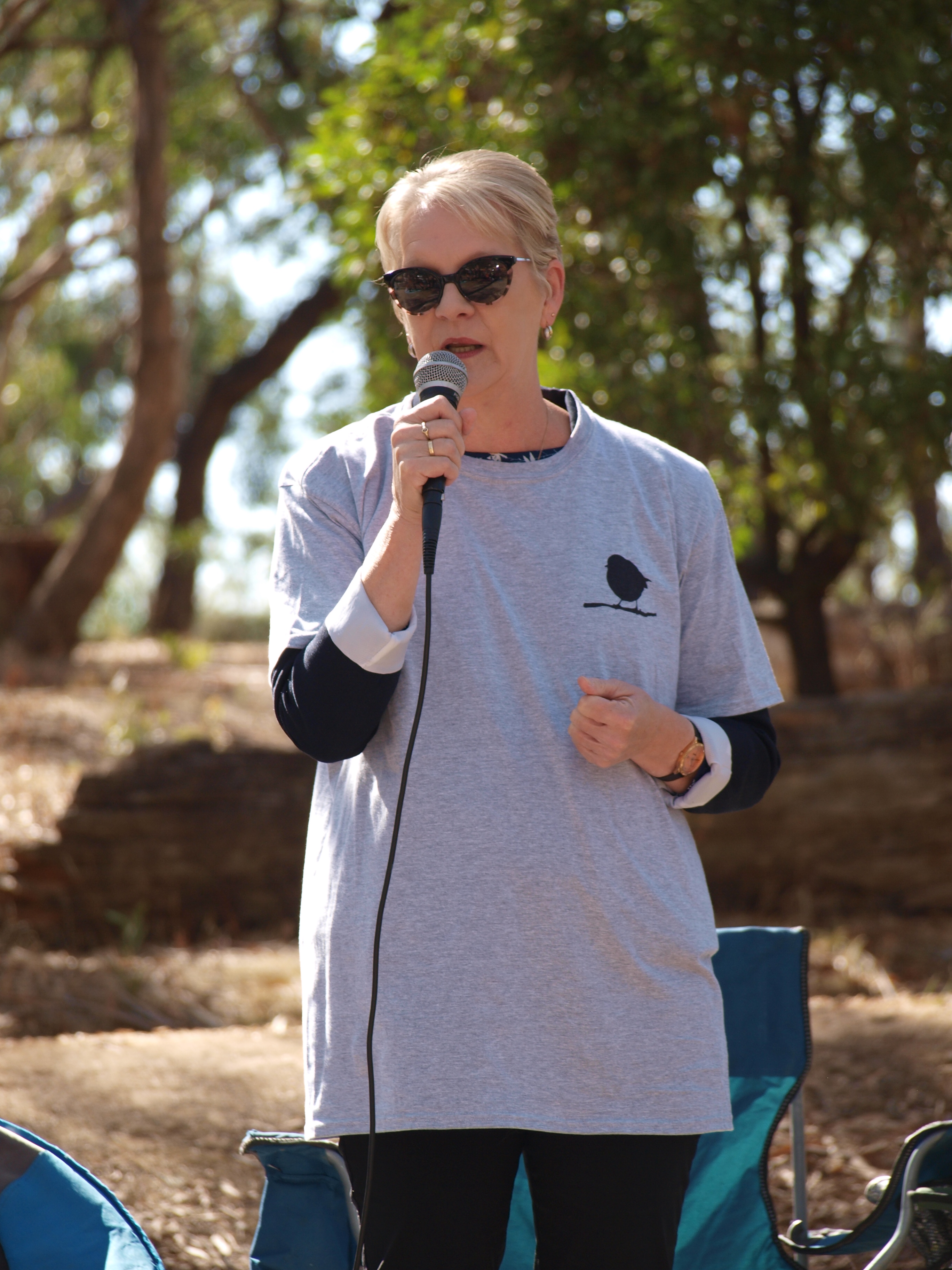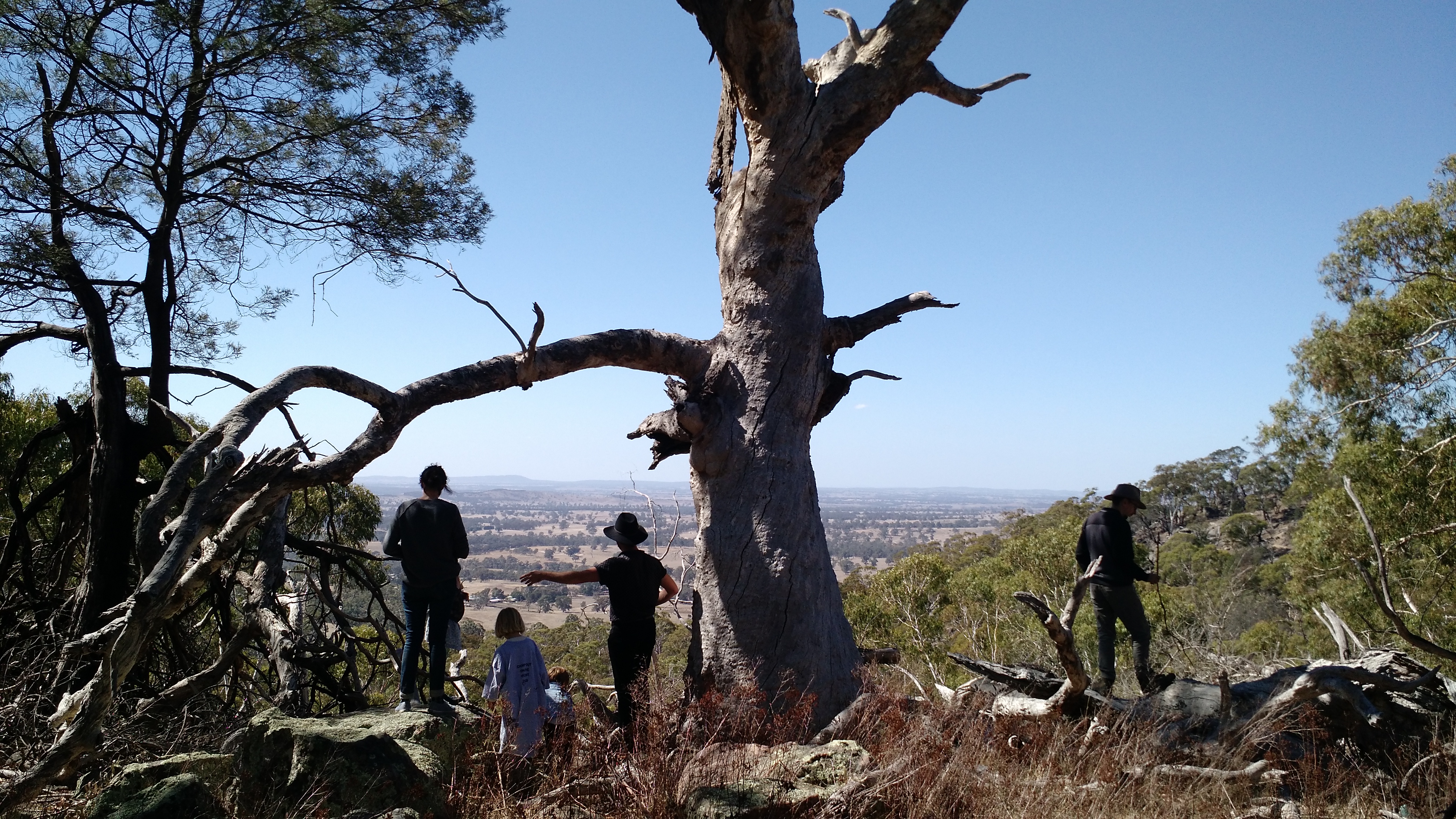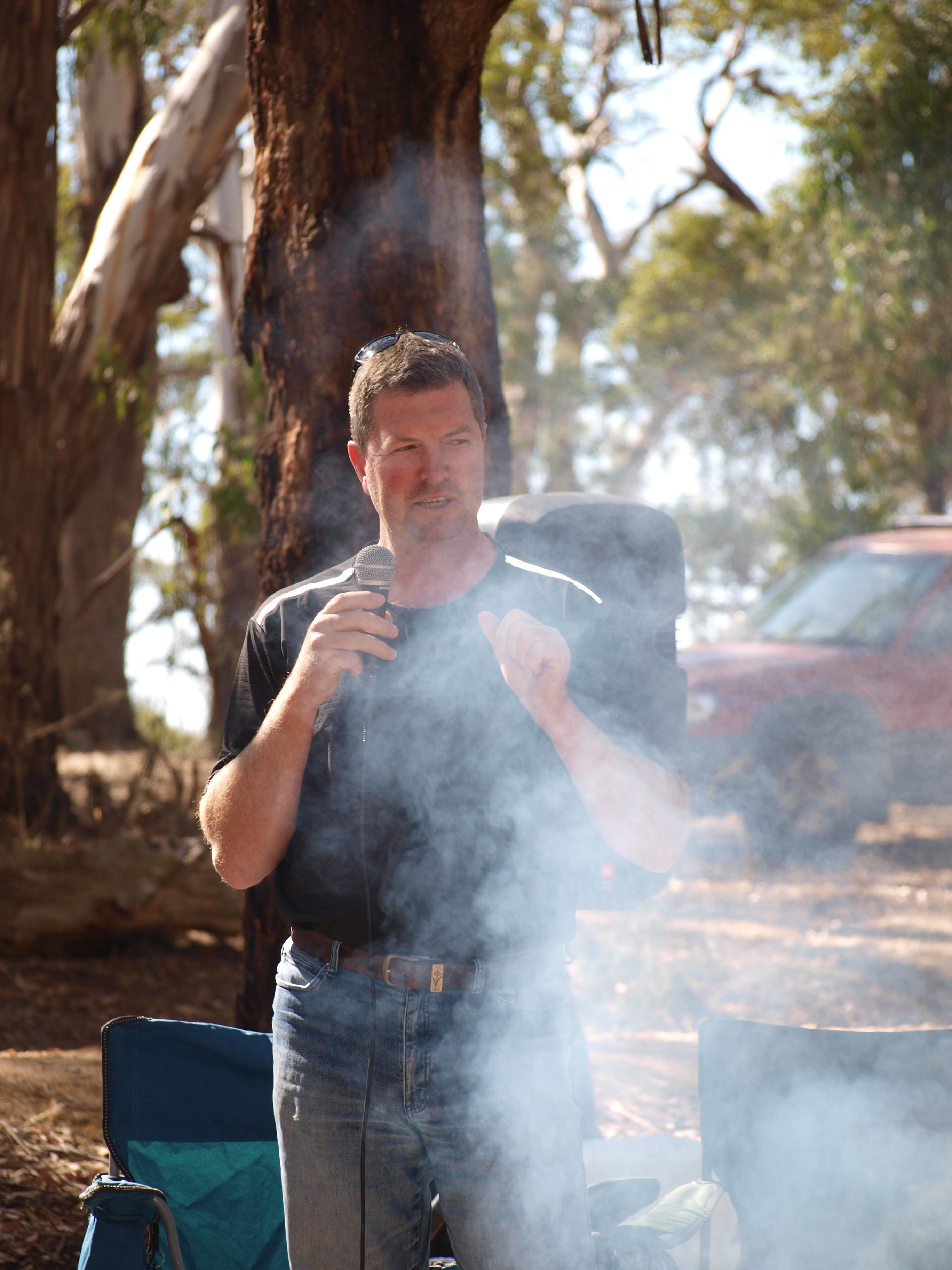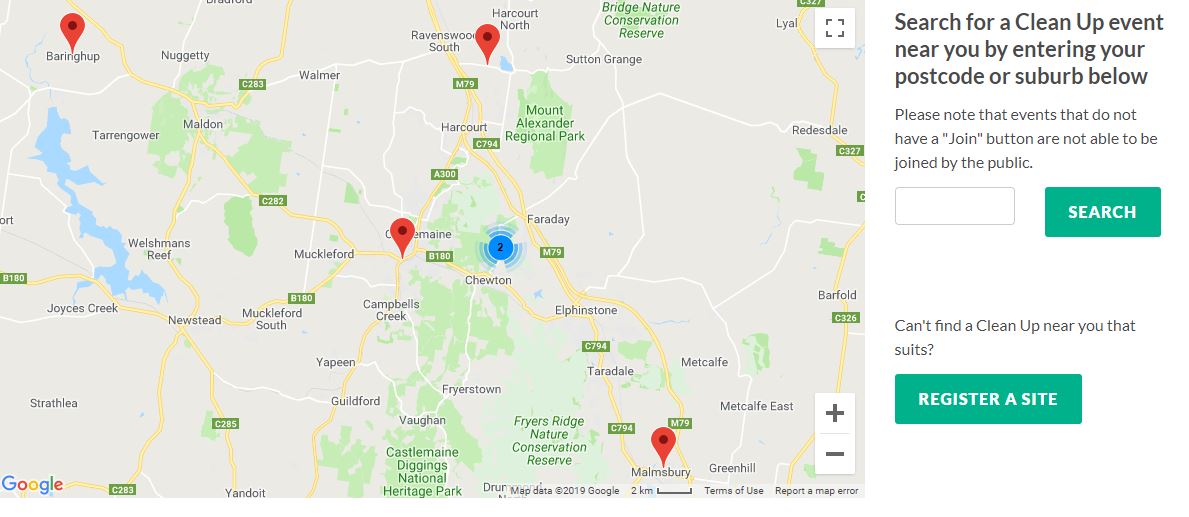Learning under the stars – Camp Out on the Mount 2019
Posted on 16 April, 2019 by Asha
Over 130 people attended the popular Camp Out on the Mount last weekend! Every year we invite people to gather for a fun night of camping and learning, to celebrate the beautiful Leanganook/Mount Alexander and the work that Landcare and Friends groups do all year round.
Saturday evening commenced at Leanganook Camping Ground with a beautiful Welcome to Country from Aunty Kerri Douglas representing Dja Dja Wurrung. She invited everyone to take off their shoes and connect to country around the campfire. Harcourt Lions Club prepared and served a delicious BBQ to the crowd. Once the coals in the campfire had settled in, the Mellick-Cooper family carried on tradition by setting up their damper-making table for all to share.
As the sun set, Mike Hayes from Parks Victoria gathered a group of about 50 together to set out on a spotlighting night walk through the bush. The group included all ages from babies to teenagers to adults. The group spotted two Brush-tailed Possums – a delight for everyone, but especially special for our visiting students from France!
On Sunday morning, campers were woken by a chorus of birds and a sunny morning. Things kicked off again with morning tea provided by Murnong Mummas, followed by a Welcome to Country and smoking ceremony with Uncle Michael Bourke. With a further welcomes from Maree Edwards MP, Connecting Country, Little Habitat Heroes, and Harcourt Valley Landcare, local legend George Milford then facilitated a discussion between local experts, including Terri Williams (Bendigo TAFE), Michael Bourke (Dja Dja Wurrung Clans Aboriginal Corporation), Ian Braybrook and Marilyn Bennet (authors of ‘Sarah’s search – a silk odyssey’). They spoke about the values of the mount from the perspectives of the environment, culture, and heritage.
Local musician Eva Popov delighted us with her song, ‘Seeds that grow’, encouraging everyone to join the chorus around the campfire. The song is about the mount and the revegetation planting done by Little Habitat Heroes.
Little Habitat Heroes volunteers ran a lovely Bush Playgroup where kids could do things like play with clay and colour in pictures of wildlife while listening to the talks and singing.
Keen participants then joined a special activity to clean native Tree Violet seed ready for planting, kindly donated by Frances Cincotta from Newstead Natives. All were encouraged to take some seed home to grow their very own Tree Violet, which provides habitat for native birds and other wildlife.
To wrap up the weekend, everyone was invited to make their way down to the Old Silk Worm Farm site to see the heritage ruins and the amazing land restoration work done. Work so far includes pine removal at past Camp Out on the Mount events, and revegetation of 900 plants by Little Habitat Heroes with support from Connecting Country. Free ‘Camp Out on the Mount’ t-shirts, designed and printed by Big Tree T-shirts and funded by Mount Alexander Shire Council, were a great souvenir for people to take home.
This free annual event was organised by Connecting Country, Little Habitat Heroes and local Landcare groups, supported by funding from North Central Catchment Management Authority through the Victorian Landcare Program, and Friends of the Box-Ironbark Forests. Connecting Country and Little Habitat Heroes would like to say a huge ‘thank you’ to everyone who helped to make the weekend a success, including everyone who volunteered their time to make sure things ran smoothly.
Reminder to register: Camp Out on the Mount 2019
Posted on 21 March, 2019 by Ivan
Just a reminder to register for the Camp Out on the Mount 2019!
CLICK HERE to visit the booking website and register for this free event. This helps us to prepare for the right amount of people for each activity and create a fun environment for all (and provide plenty of food!). Updates will also be emailed to all who register closer to the weekend, with further information on activities and what to expect.
For more information, CLICK HERE to visit our web page about this year’s Camp Out.
When: Saturday 6 – Sunday 7 April 2019
Where: Leanganook Camping Ground, Joseph Young Drive, Mount Alexander Regional Park, Faraday VIC
What to bring: Camping gear and supplies, food for Sunday breakfast, gold coin donation or Saturday night BBQ, weather-appropriate clothes, sturdy shoes and sun protection.
If you have any questions, please call Asha on (03) 5472 1594 or email asha@connectingcountry.org.au
Local couple donate $1 million for vital habitat links
Posted on 21 March, 2019 by Ivan
In a major act of biodiversity kindness and long-term vision, local residents Caroline and Terry Bellair have donated savings of $1 million to Bush Heritage Australia to convert private property into nature reserves and help create habitat links for plants and animals to adapt to a changing climate. Terry and Caroline are members of Friends of Campbells Creek Landcare and cherish their local environment and the achievements of their active Landcare group.
Some of the inspiration for the couple came after hearing Jeroen van Veen from Bush Heritage talk at an event organised by Connecting Country in Campbells Creek in 2018, called ‘Planting for the Future’ – part of our ‘Future-Proof your Restoration’ series. This event featured three guest speakers on the topic of adapting to a changing climate (click here for details). Jeroen spoke about Bush Heritage’s private property conservation program and some of the amazing outcomes the organisation has achieved through purchasing private properties with high conservation value. For example, Bush Heritage is working to link up isolated bits of habitat around St Arnaud and Wedderburn in northwest Victoria. Habitat fragmentation is a huge conservation challenge, with many areas of forest cleared for farming and mining, resulting in small, disconnected habitat havens and climate refuges.
The day after the Connecting Country event, the family began the process of donating a million dollars to Bush Heritage. The original plan was a bequest in their will, but that was soon changed to an immediate donation, allowing them to see the impacts of the Bush Heritage purchase. Over 15 years, Bush Heritage has bought more than 1,500 hectares to connect habitat in the Kara Kara-Wedderburn Landscape.
Bush Heritage also hopes to buy another nearby block with the Bellair donation, on top of the 203 hectare block near Emu, which will help form a chain between Wedderburn and the Kara Kara National Park.
For more information on the Bellair’s generous donation, click here.

Caroline and Terry Bellair have donated a generous and long-lasting gift to the planet. (Source: Meredith O’Shea, The Age)
The remarkable world of wild orchids with Newstead Landcare – 21 March 2019
Posted on 14 March, 2019 by Ivan
Newstead Landcare group are delighted to present a talk by Emily Noble on ‘The remarkable world of wild orchids’ at 8.00 pm on Thursday 21 March 2019 at Newstead Community Centre.
Emily is the Secretary of the Field Naturalists’ Club of Ballarat and Business Manager of the Ballarat Environment Network. She’s also Coordinator of the 540 ha Clarkesdale Bird Sanctuary in Linton (Victoria) for Birdlife Australia, and proud owner of a bush block south-west of Ballarat that is home to at least fifty different wild orchids. However, she still finds time to pursue her interest in orchids and their interactions with the co-inhabitants of their environment.
Trying to catch these interactions on camera provides her with many unexpected insights into their ecology, helping inform her conservation activities, and providing a source of ongoing wonder.
Come along to learn more about these remarkable plants and their fascinating relationships with their world. Newstead Landcare welcomes everyone to Emily’s presentation and supper afterwards (and promises there will be no business meeting to sit through!).
The remarkable world of wild orchids’ talk by Emily Noble
When: Thursday 21 March 2019 at 8.00 pm
Where: Newstead Community Centre, 9 Lyons St, Newstead VIC
Bring: a gold coin donation would help be appreciated to help cover costs
For those interested in reading more about the Clarkesdale Bird Sanctuary in Linton, please click here.
Linking up Landcare
Posted on 14 March, 2019 by Asha
So many stories, so little time! Thirteen of our local Landcare and Friends groups shared stories of their work with about forty other fellow Landcarers and other community members at the recent Landcare Link-up. It was great to see so many inspiring Landcarers in the same space, and hear about the great work being done in our community to care for the land.
With so many stories to share, we can’t fit them all into one blog post! So here is a small taste of what each group spoke about – if anything piques your interest, please go ahead and contact the group to chat more!
Friends of Campbells Creek Landcare – Proposed project for platypus monitoring using DNA sampling in Campbells Creek.
Nuggetty Land Protection Group – Launch of their most recent publication, the ‘A History of Seventeen Central Victoria Schools’, and their struggle with kangaroo population numbers.
Tarrangower Cactus Control Group – Using Cochineal beetles as biocontrol to support Wheel Cactus management.
Maldon Urban Landcare Group – Monitoring and protecting large old trees on public land in Maldon.
Elphinstone Land Management Association – Successful projects including an arboretum, winter solstice bonfire and nature walks.
Golden Point Landcare – Dealing with the challenges of climate change impacts, e.g., new weeds, lower revegetation survival rates.
McKenzies Hill Action and Landcare – Impacts of cats on wildlife and challenges of encouraging responsible pet ownership.
Muckleford Catchment Landcare – Keeping Landcare fun with activities such as bike rides, kid-friendly working bees and social gatherings.
Barkers Creek Landcare and Wildlife Group – Successes of their group, including holding meetings over morning tea at working bees, the ‘B-team’ works crew, and following up on-ground works with maintenance.
Friends of the Box-Ironbark Forests – FOBIF’s 2019 walks program, which are held on the third Sunday of the month.
Guildford and Upper Loddon Landcare – Revegetation project on the Guildford Plateau to provide wildlife corridors and shelter belts.
Taradale Landcare – Collecting and propagating seed has created many learning and community engagement opportunities.
Post Office Hill Action Group – The history of Post Office Hill and information about a new map soon to be released.
For contact details and more information about the Landcare and Friends groups in the Mount Alexander region, CLICK HERE.
Clean Up Australia Day – 3 March 2019
Posted on 26 February, 2019 by Asha
Join a Clean Up Australia Day working bee this weekend.
CLICK HERE to find an event near you, or see the map below.
Clean up Campbells Creek
Friends of Campbells Creek Landcare are also holding a Clean Up Australia Day working bee that isn’t on the map.
Date: Sunday 3 March 2019 from 9.00 to 11.00 am, followed by morning tea
Meet: Winters Flat Footbridge, Johnstone Street, (Midland Highway), Castlemaine VIC
Provided: Collection bags, rubbish skip (courtesy of the Council), tea/coffee and biscuits
Please bring: Hats, gloves, sturdy clothing, enclosed boots/shoes, sun protection, a rake if you have one, your own water, and a friend!
New Landcare stories booklet available
Posted on 20 February, 2019 by Asha
Readers of our local Midland Express newspaper in 2018 were treated to a series of ‘Landcare stories’, published each month as part of Connecting Country’s ‘Nature News’ series. These stories are now available to read in electronic format (as pdf file), or as a printed booklet. Click here to download the file, or drop in to the Connecting Country office for a hard copy.
There are nine stories, titled:
- Historic gum trees of Maldon
- The birth of the Cactus Warriors!
- A tiny frog inspires land restoration
- Barkers Creek gets beautiful
- From tip to bushland: Sandy Creek Landcare success
- Helicopters to the rescue
- A cup of tea to care for Jim Crow Creek
- A community cares for Campbells Creek
- The restoration of Taradale Landcare
The stories were jointly written by Sarah Edwards and Landcare volunteers between 2017 and 2018, and edited by Connecting Country. This followed a series of interviews between Sarah and local Landcarers, who included Bev Phillips, Lee Mead, Christine Kilmartin, Daryl Colless, Lois Larkman, Christine Brooke, Maurie Dynon, Thea King and Brian Bainbridge. They cover a small portion of the work done by Landcare and Friends groups in the Mount Alexander region of central Victoria.
Thank you to all who dedicated time to put these together and help share some of the many Landcare stories out there.
Camp Out on the Mount 2019
Posted on 14 February, 2019 by Asha
It’s that time of year again! Details of the sixth Camp Out on the Mount are now available and registrations are open. Please join Connecting Country, Little Habitat Heroes and local Landcare groups to celebrate the beautiful Leanganook (Mount Alexander) and the fabulous work that Landcare and Friends groups do all year round.
This free event is supported by funding from the North Central Catchment Management Authority through the Victorian Landcare Program, as well as Mount Alexander Shire Council, Friends of the Box-Ironbark Forests, and Little Habitat Heroes. We will have guest presenters from Dja Dja Wurrung Clans Aboriginal Corporation, Parks Victoria and Bendigo TAFE, along with local authors and artists. Yummy food will also be provided by the Harcourt Lions Club, Murnong Mummas, and the Camp Out Damper Team.
CLICK HERE to visit the booking website
CLICK HERE to download the flier
When: Saturday 6 – Sunday 7 April 2019
Where: Leanganook Camping Ground, Joseph Young Drive, Mount Alexander Regional Park, Faraday VIC
What to bring: Camping gear and supplies, food for Sunday breakfast, gold coin donation or Saturday night BBQ, weather-appropriate clothes, sturdy shoes and sun protection.
Below is a run-down of the Camp Out on the Mount 2019 program. You are more than welcome to attend some or all of the activities. Please let us know through the booking website which activities you plan to attend, as this will help us in planning how many people to cater for.
If you have any questions, please call Asha on (03) 5472 1594 or email asha@connectingcountry.org.au
Please note: activities will be cancelled in the case of severe weather.
SATURDAY 6 APRIL
5:30 pm Welcome to Country
6:00 pm Lions Club BBQ and damper (gold coin donation)
7:30 pm Night walk with Parks Victoria ranger
OVERNIGHT CAMP OUT (BYO camping gear and supplies)
SUNDAY 7 APRIL
9:30 am Bus down to Old Silk Worm Farm site
10:00 am Welcome and morning tea
10:30 am Panel of local experts talk about the Mount, including Rebecca Phillips (Dja Dja Wurrung Clans Aboriginal Corporation), Terri Williams (Bendigo TAFE), and Ian Braybrook and Marilyn Bennet (authors of ‘Sarah’s search – A silk odyssey’), facilitated by George Milford
11:30 am ‘Seeds that grow’ song performed by Eva Popov
11:45 am ‘Make you own native seed balls’ activity
12:30 pm Bus back to camp site
Act now for Rabbit Buster Month
Posted on 5 February, 2019 by Asha
February marks ‘Rabbit Buster Month’. This successful campaign began in the 1990s and continues to serve as a reminder to plan for and act on rabbit control.
Rabbit monitoring
It’s easy to observe when rabbit populations are high as damage is noticeable, but it can be hard to know when populations are building. Ensuring rabbits have minimal impact within a specific area requires regular monitoring. If rabbit numbers reach unacceptable levels, immediate control actions are required.
Useful rabbit monitoring techniques that landholders can implement on their own properties are described in the following documents:
Rabbit control
If rabbit numbers reach levels which require control, an integrated approach using a range of techniques usually works best. Methods can include fumigation, shooting, baiting using pindone, ferrets, warren ripping and netting. Most of these techniques require specialist practitioners with appropriate licences and accreditation, with their associated equipment and other costs.
A cost-effective way for landholders to get started with rabbit control is to establish one or more rabbit bait stations, using an oat bait with pindone poison as the active ingredient. Your local rural supply merchant can supply this product and advice.
Click on these links for useful information for setting up your own bait station:
- Connecting Country Instructional Video 1: How to make a rabbit bait station
- How to use rabbit bait stations effectively
- Bait stations and rabbit control
However, the most effective rabbit control uses a range of techniques and constant vigilance. The good news is that even the most rabbit-affected properties can be brought under control, and the rabbit numbers maintained at very low levels.
Rabbit biocontrol
Rabbit biocontrol, such as introduction of a rabbit virus, can be most beneficial if applied as part of an integrated and complementary pest management approach. Here are some statistics about the release of a new rabbit virus (from the February 2019 North Central Chat newsletter):
- The RHDV1 K5 rabbit virus was officially released at 382 locations nationwide.
- Sites included 373 community-run release sites and nine intensively monitored releases sites.
- Some sites did not progress due to low rabbit numbers, timing or poor weather conditions.
- 42% of sites recorded a reduction in rabbit numbers post-release (based on data from 191 release sites).
- Through laboratory analysis, RHDV1 K5 rabbit deaths were confirmed in every state and territory, except the Northern Territory.
Further information
If you would like a hard copy of Connecting Country’s ‘Ute Guide to Rabbit Control’, contact our office on (03) 5472 1594 or email info@connectingcountry.org.au
To visit the Victorian Rabbit Action Network website, click here
To download the February 2019 North central Chat, which includes a Rabbit Buster Month feature, click here
To download a copy of Connecting Country approved contractor list, click here
Pizza party in the park – Intrepid Landcare
Posted on 14 January, 2019 by Asha
Are you a young person? Do you want to help care for our land and the environment?
Do you like pizza???
Come along and chat about starting an Intrepid Landcare group for people aged 18-35 years. Pizza and music provided, BYO drinks. Call or text 0418 428 721 for more information.
When: Saturday 9 February 2019 from 7:00 to 9:00 pm
Where: Castlemaine Botanical Gardens (near the rotunda), Castlemaine VIC
CLICK HERE to download the flier, and please feel free to share!
Tarrangower cactus warriors honoured again with national Froggatt Award
Posted on 2 January, 2019 by Frances
They’ve lured university students, local scouts and even Work for the Dole crews into their scheme to rid invasive wheel cactus from their part of Victoria, and now a little community group in central Victoria has received a national Froggatt Award.
‘The Tarrangower Cactus Control Group have gone to extraordinary lengths to turn the tables on wheel cactus, a weed that escaped gardens in the 1960s and began taking over local bushland,’ Invasive Species Council CEO Andrew Cox said when announcing the award.
‘Their passion for protecting the natural environment from wheel cactus, a highly invasive and extremely difficult plant to kill, has roped all sorts of people into their program. University students, local scouts and even drought relief and Work for the Dole crews have all joined the cause to rid the area of wheel cactus.’
The Tarrangower Cactus Control Group has contributed to state and national policy development, including the first-ever Victoria-wide map of wheel cactus and the Managing Opuntoid Cacti in Australia manual.
Scroll through this gallery for photos of their amazing work.
Froggatt awards were also given this year to an intrepid band of bushwalkers who led a feral horse protest walk all the way from Sydney to Mt Kosciuszko and to the creators of a green-haired Biosecurity Warrior.
About the Froggatt Awards
Invasive species have become one of the biggest threats facing Australia’s natural environment, but their continued arrival and spread is all too often neglected as a conservation issue.
The Froggatt Awards are given out by the Invasive Species Council every year and are named in honour of Australian entomologist Walter Froggatt, a lone voice in the 1930s warning of the dangers of releasing the cane toad into Australia to control beetle infestations in sugar cane.
The awards are given to those who have made a major contribution to protecting Australia’s native plants and animals, ecosystems and people from dangerous new invasive species.
More information
The restoration of Taradale Landcare
Posted on 17 December, 2018 by Asha
If you read the Midland Express newspaper, you may have been enjoying Connecting Country’s monthly ‘Nature News’. This year we featured Landcare stories written by intern Sarah Edwards and local Landcarers. This week, the last of these ten stories was published in the paper, featuring this story written by Brian Bainbridge about the wonderful Taradale Landcare.
Taradale Landcare Group came together over twenty years ago over their shared passion for walking in the bush, managing the land, and learning about native flora and fauna. After many years of committed work, eventually the group lost momentum and folded in 2012.
Following a meeting to gauge interest, several prospective new members and a sprinkling of original members reformed Taradale Landcare in 2016.
Things started slowly with meetings and discussions to learn about the member’s priorities and interests- as well as conducting the ‘house-keeping’ needed to re-establish the group’s organisation and accounts. The Back Creek alongside the Mineral Springs Reserve near the centre of town has become a natural focus and base. The group has resurrected the work of the earlier group by treating weeds, uncovering the now maturing plantings, and replanting to fill in the gaps. In 2018, a Mt Alexander Shire Roadside weeds grant has encouraged the group to learn to coordinate and conduct sensitive weed control along the best roadside remnants, a process expected to continue for several years.
The group’s walks and talks encourage exploration by the many newly arrived residents of their adopted town’s historical sites including the Channel, Barkly Park, the Cemetery and the Quartz Battery, each with important ecological values that could be enhanced. This summer will see the group conduct seed collection (under permit) and propagation of wildflowers, grasses and trees- in consultation with the Cemetery trust.
A theme of the newly emerged group is to engage and have a presence at local gatherings while ensuring the group’s own events have a social as well as ecological outcome. Shared meals encourage the sharing of ideas to continue long after the ‘real’ work has ended.
If you are interested in being a part of Taradale Landcare Group or have any questions, email Colleen Jones at colfjones@yahoo.com.au or like the group’s Facebook page at https://www.facebook.com/taradalelandcare/.
New climate change resource launched!
Posted on 7 November, 2018 by Asha
 To complement Connecting Country’s recent ‘Future-proof your restoration‘ seminars, we’re pleased to launch a new three-part resource to support landholders and Landcare groups interested in learning more about adapting land management to a changing climate.
To complement Connecting Country’s recent ‘Future-proof your restoration‘ seminars, we’re pleased to launch a new three-part resource to support landholders and Landcare groups interested in learning more about adapting land management to a changing climate.
Part 1 – resource links: A new Useful resources page on our website added to our existing collection of pages on Biodiversity and Climate Change. The address for this web page is https://connectingcountry.org.au/education-resources/take-action/biodiversity-and-climate-change/future-proof-your-restoration-useful-resources/ Here you will find a series of links to download resources related to biodiversity and climate change in our region, including information on weed control, revegetation and planning. There are also links to download copies of the presentations from the ‘Weeds to Watch’ and ‘Planting for the Future’ seminars. If you would like hard copies of any of the linked resources, please email asha@connectingcountry.org.au
Part 2 – info summary: If you’d like a bite-sized version of some of the information linked to on the web page, you can CLICK HERE to download a document we’ve put together summarising interesting facts.
Part 3 – fact sheet: Connecting Country’s brand new ‘Future-proof your restoration’ fact sheet. CLICK HERE to download a copy, or drop into the office if you’d like some hard copies to hand out to your friends!
Thank you to the North Central Catchment Management Authority for funding this project through the Victorian Landcare Program, and to GreenGraphics for designing and printing the information sheet.
New brochure – Landcare in the Mount Alexander region
Posted on 1 November, 2018 by Asha
Did you know we have around 30 Landcare and Friends groups in the Mount Alexander region? This is potentially the highest density of groups in the whole of Victoria!

David, Rob, Asha, Sharon, Barry, and Ian at the Landcare Week stall at the Maldon Market (photo courtesy of the Tarrangower Times).
During September 2018, you may have spotted one of our five Landcare Week stalls on the streets of Castlemaine or at our local markets. Here we chatted with passers-by about the wonderful work Landcare groups do, and handed out brochures and other resources. These included the newest edition of the Landcare in the Mount Alexander region brochure.
The new brochure looks amazing, thanks to the hard work of Jane Satchell, one of Connecting Country’s landholders, who kindly volunteered her professional graphic design skills. In the brochure you will find information about what Landcare groups are all about, how you can get involved, a map showing all of our local groups, and contact details for each group.
CLICK HERE to download your very own copy, or drop into the office to pick one up.
Thanks to Jane for all her help with the brochure, and to the many generous volunteers who helped at the Landcare Week stalls.
Winners in our eyes
Posted on 24 October, 2018 by Asha
Landcare in the Mount Alexander region was well represented at the recent National Landcare Conference in Brisbane. Both Ian Higgins (Friends of Campbells Creek) and the Cactus Warriors (Tarrangower Cactus Control Group) were up for National Landcare Awards. Sadly neither were awarded first place, but we appreciate the incredible work they do for our community and environment regardless of a trophy! We thank them for all for their achievements and the hard work they continue to do.
The nominees put together videos in the lead up to the awards, which are worth checking out: CLICK HERE for the Cactus Warriors’ video and CLICK HERE for Ian Higgins’ video. Friends of Campbells Creek was also featured recently on WIN news – CLICK HERE to view the clip. These videos showcase the amazing difference our local Landcare groups make. Please share them around if you can.
Both groups have events on this Sunday 28 October 2018, so you may have to make a hard choice!
For information:
- On the Cactus Warriors last community field day for the year, CLICK HERE
- On the Friends of Campbells Creek‘s next working bee, CLICK HERE
Here are Ian Higgins and the Cactus Warriors enjoying the National Landcare Conference (photos by Asha Bannon).
Echidna presentation and Newstead Landcare AGM – 18 October 2018
Posted on 16 October, 2018 by Jacqui
Newstead Landcare is delighted to have Dr Kath Handasyde from The University of Melbourne to speak at their AGM at 8 pm this Thursday 18 October 2018 at Newstead Community Centre (9 Lyons St, Newstead VIC).
The AGM will be speedy then we can all enjoy Kath’s presentation about one of only two Australian egg-laying mammals – the Echidna.
Echidnas are our most widely distributed mammals, occurring in all regions of Australia. They are classified as myrmecophages, feeding extensively on social insects, such as ants and termites.
These are a rich and abundant food resource for which echidnas have clear adaptations, such as a long narrow snout, sticky tongue and powerful digging abilities. Echidnas are one of the relatively small number of Australian mammals that undergo hibernation.
Please come along to hear some more about these extraordinary animals in a presentation about their ecology and behaviour.
All welcome! A gold coin donation will be appreciated to help cover costs.
Woodland birds of central Victoria with Chris Tzaros – 13 October 2018
Posted on 9 October, 2018 by Asha
Axe Creek Landcare invites you to:
Working with Nature — conserving woodland birds with special guest, Chris Tzaros (Birds, bush and beyond)
- Join Axe Creek Landcare for a visual extravaganza of award winning bird photography from wildlife ecologist Chris Tzaros.
- Learn about the habitat requirements of our woodland birds, why some are endangered and what conservation actions you can do to reverse local declines.
- Meet neighbours and people and network to develop ideas for future on-ground activities.
- Join optional local field trip for those interested in learning more in the field.
- Light lunch provided.

When: Saturday 13 October 2018 from 10:00 am – 3:00 pm AEDT
Where: Emu Creek Hall, Cnr Emu Creek and Hargreaves Rd, Emu Creek (via Strathfieldsaye), VIC 3551
Bookings: click here
For more information please contact Adrian Martins on 0427 099 376.
National Waterbug Blitz Workshop
Posted on 27 September, 2018 by Asha
Help monitor the health of waterways in the Mt Alexander region!
North Central Waterwatch, Castlemaine Landcare Group and the Friends of Campbells Creek are working together to engage local community members in monitoring the health of Forest Creek, Barkers Creek and Campbells Creek in the Mt Alexander region. They will be providing an introduction to and training in water quality monitoring and waterbug assessments to those citizen scientists wishing to join the program.
Water quality monitoring looks at the temperature, turbidity, salinity, nutrient and pH levels of water, to helps us understand how conditions change over time. Waterbugs (or macroinvertebrates) are excellent indicators of river health and one way we can measure the success of remediation work over time.
Join these groups, together with John Gooderham (freshwater ecologist and co-author of ‘The Waterbug Book’) for this accredited workshop. You will learn the Agreed Level Taxonomy (ALT) macroinvertebrate method of identifying waterbugs and how to use water quality monitoring equipment. They will demonstrate how we can use this information to assess creek health, and show you how you can be a citizen scientist.
Each year North Central Waterwatch, in partnership with Castlemaine Landcare Group and the Friends of Campbells Creek, will release an Annual River Health Snapshot Report. The report will highlight changes in ecosystem health of these waterways using data collected by citizen scientists.
North Central Waterwatch is hosting a registration day and training session on Campbells Creek – please come along!
Campbells Creek – National Waterbug Blitz
When: Tuesday 16 October 2018 from 10.00 am – 2.30 pm
Where: Campbells Creek Swimming Pool Reserve, Midland Highway, Campbells Creek VIC (across the road from Beards Hardware). A map will be provided following registration.
Cost: Free event, lunch is provided.
To register: Click here or call 03 5448 7124
Bring: If you have them, bring gumboots or waders, waterbug ALT guide, magnifying glasses, camera and smart phone.
Download the Waterbug App from your App store prior to the event.
Water workshop with Muckleford Catchment Landcare
Posted on 18 September, 2018 by Asha
Let the rain run in, not off – an introduction to landscape function on a farm in transition
Join Muckleford Catchment Landcare at a workshop on how water functions in our landscape, presented by Muckleford landowner and ecologist, Paul Foreman, and land planning consultant, David Griffith.
Do you have cleared paddocks and want them to be more healthy and productive from both farm and conservation perspectives? Have these experts answer your questions about how you want your property to work.
Date: Sunday 23 September 2018
Time: 10 am to 12 noon
Location: Paul’s property at 678 Lewis Road, Muckleford VIC
Parking behind the house. Morning tea provided.
Please RSVP to Beth via email or call on 0431 219 980.
Learn about landscape connectivity: science and practice
Posted on 18 September, 2018 by Asha
Newstead Landcare are hosting an interesting talk this Thursday.
Dr Jim Radford (Principal Research Fellow from the Research Centre for Future Landscapes, La Trobe University) will talk about the science and practice of connecting landscapes, what works and what we should be aiming for in landscape restoration projects.
Jim will focus on the benefits of revegetation in restoring rural landscapes, guiding principles for landscape restoration, and priorities and guidelines to improve landscape connectivity.
Landscape connectivity: science and practice
Venue: Newstead Community Centre, 9 Lyons Street Newstead VIC
Date: Thursday 20 Sept 2018
Time: 8 pm to 9 pm followed by supper
A gold coin donation would be appreciated to help cover costs.



